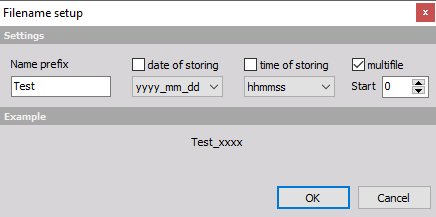Storing strategies are very important for the entire system. That's why Dewesoft X offers many ways of how to store data.
You can see all the storing options in Measure mode under the Storing tab.
 Image 1: Storing options
Image 1: Storing options These are the possible storing options in Dewesoft X
- Always fast
- Always slow
- Fast on trigger
- Fast on trigger, slow otherwise.
With always fast and always slow storing options you can choose between different static acquisition rates and units.
When you select one of the trigger-based storing options, the Trigger setup tab will automatically appear on Dewesoft X Setup screen.
NOTE: With Dewesoft X, you can trigger from your signals by setting any channel(s) to start and stop recording according to levels.
Before we explain other functions on the screen above, let's first take a look at how to name and save files that will be stored.
We can change the folder where data is stored under the Folder section.
 Image 2: Data files folder
Image 2: Data files folder
| Project data files folder | Folder from project settings |
| Custom folder | Arbitrarily chosen folder from local storage |
You can define the file name for each measurement separately by entering it into the edit-field Image 3: File name field
Image 3: File name field
For repetitive measurements, we use the Create a multifile function.
 Image 4: Create a multifile
Image 4: Create a multifile The Multifile function automatically assigns a new file name for each cycle (start) of storage. File names can be either consecutive (such as 0001, 0002, 0003) or by the date and time.
 Image 5: Multifile name by the date and time
Image 5: Multifile name by the date and time
Additionally, you can define how a new file will be created by selecting Make a new file after checkbox. The criteria for switching to a new file are either the file size or time interval, which can be defined in seconds, minutes, or hours.
| MB | Creates new file after defined file size in Megabytes is reached |
| h | Creates new file after defined time in hours is reached |
| min | Creates new file after defined time in minutes is reached |
| sec | Creates new file after defined time in seconds is reached |
| triggers | Creates new file after the trigger occurs |
This can be very useful when acquiring data for longer time periods. If we choose to switch the file each hour with absolute time, then the switching will be done exactly on the hour (01:00, 02:00, 03:00...). The time will be taken from absolute PC time (or another more exact timing source, if available, as defined in the hardware setup). The file switch is done in such a way that no data point is lost in the process.














 data will still be acquired, but storing will be paused. At that point, the Pause button caption changes to Resume button
data will still be acquired, but storing will be paused. At that point, the Pause button caption changes to Resume button Store button stays the same
Store button stays the same



























































 button to move the limit up / down and the
button to move the limit up / down and the  button to add/remove limit in the frequency domain.
button to add/remove limit in the frequency domain.



















